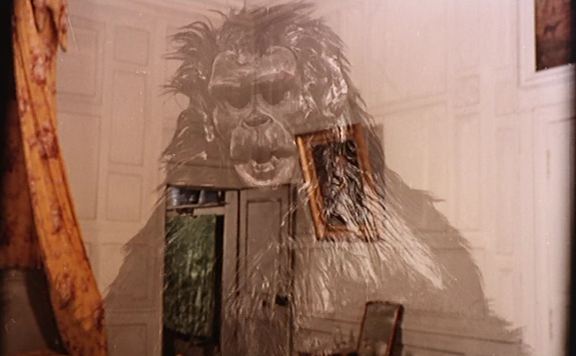Having read a few fan reviews of Orloff and the Invisible Man — or indeed Orloff Against the Invisible Man — it’s the same film! — I was led to believe that it may be strange, eccentric and wild — certainly I could expect that it would be in the anarchic, erotic and demonic spirit of Jess Franco, because Orloff is a Franco creation. It didn’t appear to be any of these things however, but that’s not to say it didn’t have value. Cinema can be about switching off, and this film is one that will definitely tick that box.
It amazes me how they used to make B-features, and how low the expectations were. As long as there was a wee bit of what the boys at my school used to call ‘titter’, then everything was all right. The lack of sophistication in Orloff Against the Invisible Man is stunning, and would never be permitted these days, not even during a television miniseries or HBO boxed set, lordy no! But as has been proved on many occasions, even amateurs with video cameras in the 1980s knew many of the basics that these guys overlooked.
A thoroughly indecent ORLOFF compliation from YouTube demonstrating the epic oeuvre's finer highlights
Director Pierre Chevalier makes a brave attempt to bore the viewers with this story. As an example, if you were describing the film to somebody, you might begin by saying something like: ‘a young provincial doctor is called to a mysterious castle,’ and that is a perfectly respectable way to start a flick. The problem here is that this palaver takes twenty five to thirty minutes of screen time, and even then we know little. The actor playing This leaves only forty minutes for explanation, monstrous activity, back story. And ‘titter’.
The ‘titter’ supplied in Orloff Against the Invisible Man forms the core of the movie, and is without doubt the most memorable scene. This is not a film known for its ‘titter’ however, but its bush. I don’t particularly like that term, but bush is the only term for what viewers of Orloff Against the Invisible Man will recoil from.
Some find the rape of the serving maid by the invisible monster hilarious, and many will find it unpleasant, but it is certainly a centrepiece. It’s a tasteless, made worse by the fact of Howard Vernon’s leering, and more confused by the serving girl’s ambiguous reactions. Anatomically, it’s more graphic than viewers are used to, simply because of poor camerawork, and at times it has the flavour of Gustav Courbet about it.
It isn’t the only invisible rape out there, and of course I’m referring to Rhona Mitra’s career spring-board outing in Paul Verhoeven’s Hollow Man, another poor taste scene. Still, it’s remarkable the difference thirty years made in terms of special effects.
I like how the character of Orloff, played by the unstoppable Howard Vernon, is like other creations, up for grabs as it were. Yes, Orloff was created by Jess Franco, but no, not every film featuring Orloff is a Franco film. This one was directed by Pierre Chevalier (you may remember him from returns for his second turn as Dr. Orloff.
I find most reviewers are kind to Orloff Against the Invisible Man, which is worse than muddled in terms of plot, and cheaper than you can imagine in terms of effects. Cheap in and of itself isn’t a problem, in fact it’s something to be commended, but when you see the invisible ‘man’ itself, you may well feel disappointed. The problem is that it is not really a man, but a man in a rented gorilla suit, the kind people wear to parties.
Aside from that, the score is impressive and wild, orchestral and crazy, with finger snaps and bashing drums; and the gratuitous nudity is so glaringly real, that you may well have to look away. I have heard one person at least write that Orloff Against the Invisible Man contains ‘the most famous bush in cinema history’, and although it may not really be famous, it has its own horrific intensity, contrasting as it does with the silicon-packed, tanned and shaved women we see in similar fare today.
Does anyone bother about sexploitation? Such films as Orloff Against the Invisible Man were made quickly and cheaply and in the US, generally exhibited in urban grindhouse theatres. By the time Orloff was released in 1971, sexploitation style films were attracting larger and wider audiences, including couples rather than the single males, but the genre declined in the 1970s due to advertising bans and the rise of other forms of pornography. The reason why I ask if anybody cares, is that the rise and fall of the sexploitation film seems in no way influenced by ideas of women’s rights. A few women even directed these films, but Stephanie Rothman is a notable exception although she says she was never happy working in exploitation films. Her influence was felt in the work of Roger Corman, with exploitation cinema is to make the sex and violence transgressive, but not repulsive, something not necessarily achieved in Orloff Against the Invisible Man.
It's not even an invisible MAN, more of an invisible man in a monkey suit
Rarely have I come across a film with more title variations. This is due to various factors, the least of which are the requirements of its various international releases. Then there’s the general confusion of the action, or inaction, and then combine this with the many edits, dubs and cuts of the original, and in effect you have several films. So far I have seen this film labelled as:
Orloff Against the Invisible Man
Orloff and The Invisible Man
La vie amoureuse de l'homme invisible (which would be The Love Life of the Invisible Man)
Orloff et l'homme invisible
Dr. Orloff's Invisible Monster
Das Schreckenshaus des Dr. Orloff (German DVD title)
Love Life of the Invisible Man (see above)
Secret Love Life of the Invisible Man (Canada)
and…. The Invisible Dead
This list even fails to take into account the normal language variations one would expect as a film travels to East Germany (Das Schreckenshaus des Dr. Orloff) or in West Germany (Der unsichtbare Tod) Italy (La morte invisibile and Le notti erotiche dell'uomo invisibile), and Spain (Orloff y el hombre invisible).
Unfortunately, Orloff Against the Invisible Man adds less than nothing to the general canon of invisibility in film. I think in fact that the only reason the creature is invisible for most of the film is that it is on the whole cheaper to have lanterns floating on strings when it’s supposed to be carrying them, and doors flying open and closed as it moves. Other than that, it’s just a case of sit back and let it happen.
Orloff Against the Invisible Man is a truly terrible film, with virtually no redeeming qualities, a bad attitude and a lazy, crazy production style. I liked it.
Trailer Presentation for ORLOFF AGAINST THE INVISIBLE MAN (1970)

